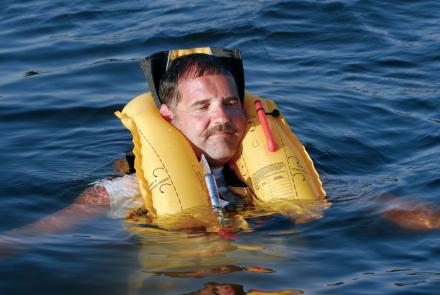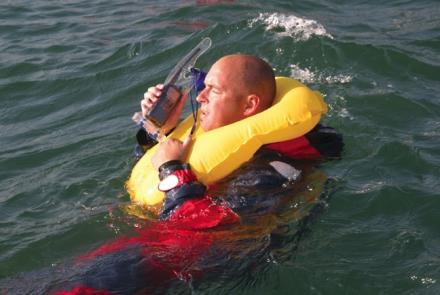Life Jacket Recommendations for Cruising Sailors
Lifejacket /Personal Flotation Device (PFD) Requirements
- Every crew member must have a lifejacket with a light, whistle, retroreflective tape and either the boat or the crew member's name on it.
- In the US, lifejackets may be approved by International Standards or by USCG.
- USCG approved PFDs can be a Type I or a yoke-type inflatable with a minimum of 33 lbs buoyancy (lbf), with or without crotch straps, face guards, or buddy line.
- Inflatable Lifejackets must be inspected annually.
- Lifejackets must be compatible with any harness worn by crew members.
Note: International Standard (ISO) approved lifejackets manufactured after 1 Jan 2012 will have an emergency light, a sprayhood (face guard), a buddy line/lifting strap, and a full deck safety harness including a crotch or thigh strap (holding down device).
When to wear Personal Safety Equipment
There are no published standards of when cruising sailors are to wear personal safety equipment. However, the regulations prescribed for racing sailors provide excellent guidelines:
- US Sailing prescribes that all personnel on deck shall wear properly fitted personal flotation while starting and finishing an event. At other times during an event flotation shall be worn on deck except when the Captain of the boat directs that it may be set aside.
- US Sailing recommends that harnesses and personal flotation devices should be worn whenever conditions warrant, and always when reefed, in rough weather, on cold water, at night, under conditions of reduced visibility, and when sailing short handed.
- US Sailing prescribes that safety harnesses and PFD's shall be worn in offshore events from sundown to sun up while on deck.
International Standard (ISO) PFDs are not currently approved by USCG. Boats operating in US waters that carry ISO lifejackets must also carry a USCG Approved PFD for each person aboard.
Notes, Warnings, and Recommendations
- International Standard (ISO) PFDs are not currently approved by USCG. Boats operating in US waters that carry ISO lifejackets must also carry a USCG Approved PFD for each person aboard.
- Many inflatable PFD's with built-in harnesses are designed for people greater than 5'6" in height and are potentially dangerous if you are below that height. (The attachment point of a harness must be "above the lowest point of the rib cage"
- It is strongly recommended that each person who is below the 5’6” height test their harness to insure that it is high enough. If not, that person should switch to a PFD with built-in harness unit that has adjustable features or to an independent adjustable harness.
- The function of lifejacket crotch/thigh straps is to hold the buoyancy element down. Before an event every crew member should adjust a lifejacket to fit, then retain that lifejacket for the duration of the event. Correct adjustment is fundamental to the lifejacket functioning properly
- "Yoke Type" is defined as a PFD that is designed to keep its wearer face-up in the water and that provides buoyancy in front of the chest and behind the neck immediately when inflated.
- ISO 12402 requires Level 150 (33 lbf) lifejackets to be fitted with a mandatory whistle and retroreflective material. Also, when fitted with a safety harness, ISO 12402 requires that this shall be the full safety harness in accordance with ISO 12401. Any equivalent lifejacket shall have equal requirements.
- Persons of larger than average build are generally more buoyant than those of average build and so do not require a lifejacket with greater levels of buoyancy. Wearing a larger Level 275 (61 lbf) lifejacket may hamper entry into liferafts.
- It is strongly recommended that all lifejackets have a splashguard/sprayhood/face guard
- It is strongly recommended that a life jacket have an AIS Locator Beacon
- It is strongly recommended that if a life jacket used offshore has a Personal Locator Beacon (PLB) unit it should be properly registered with NOAA. The name of the boat and event dates should also be included as additional information on the registration form and kept current as changes occur.
- Inflatable PFD's with the required buoyancy will generally have inflation cylinders containing 33g or more CO2.
- It is strongly recommended that a spare cylinder or activation head be carried for each gas type inflatable lifejacket.
Recent Lessons Learned
- PFD lights should be upgraded. Some ‘approved’ lights go out if they are not kept in the water. Others do not have both strobe and incandescent capability and many are not bright enough.
- Whistles should be upgraded. Some ‘approved’ whistles are not loud enough.
- Leg straps (crotch or thigh) are available and can be added to PFDs as long as they are not glued or sewn to the jacket material.
- Face guards/sprayhoods/splashguards are available as PFD accessories.
- Manual and oral inflation capability are required on inflatable PFDs. Auto Inflation is optional. Some auto inflators can be disabled by the user.
- Annual inspection of inflatable PFDs is done by orally inflating the unit and letting it set overnight. Discard unit if it loses air. Repack with a new bobbin, if PFD has an automatic inflator.
- Other PFD accessories should be considered (AIS Locator Beacon, Personal Locator Beacon (PLB), Handheld VHF/DSC, knife/cutter capable of cutting a tether/safety line, signal mirror, pocket flares, water dye, shark repellant). Every accessory should be tied to the PFD with a length of twine so they will not be lost in the water.
- Remember that ‘you go as you are’ if you go into the water. Having all of the ‘right’ safety equipment is useless if you don’t wear it!
Questions, Comments, Suggestions to rontrossbach@msn.com




